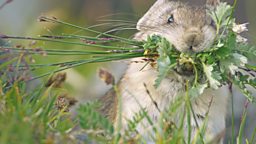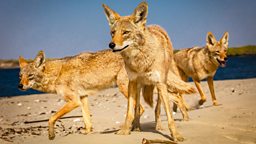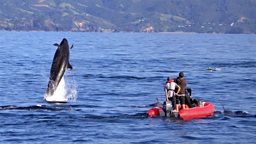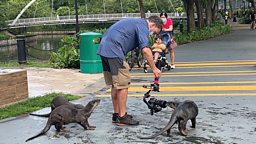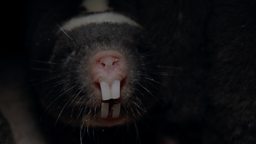Uncovering the world of the wolverine
By Tom Glass, University of Alaska Fairbanks

In March 2016, I cracked open the lid of a stout wooden box on Alaska's North Slope and was met with a growl. Two umber eyes flashed in the beam of my light, then disappeared as the animal gathered itself and lunged, jolting the 300-pound trap. I jerked back in surprise.

In those early days of the Wildlife Conservation Society Arctic Wolverine Ecology project, studying wolverines in the Arctic could feel like a fool’s errand. Would an animal that had never seen a tree enter a lumber trap? Would they be tempted by the scent of beaver, a species they'd never met? Until the lunging wolverine answered yes, all we had was months of preparation and a mountain of hope.
Before our project, little was known about wolverines north of the tree line. Questions like “What kind of habitat is important for wolverines in the Arctic?” and “How vulnerable are they to climate change?” remained largely unaddressed. Now, with modern GPS collars, we sought to better understand wolverines’ needs – and vulnerabilities – in this wind-scoured land.
The Arctic is changing. Spring thaw arrives days, sometimes weeks, earlier each decade. Cargo ships navigate newly ice-free routes, and a vanguard of southern wildlife species – moose, hares, and, yes, beavers – are striking north from the shadowed protection of forests onto this softening tundra. Meanwhile, tendrils of development snake farther each year, roads and pipelines carrying oil, gas, and minerals south.
. Their indiscriminate scavenging exposes them to new prey species and diseases entering an area (and, conversely, can signal a species’ loss). for reproductive dens may make them susceptible to earlier thaw. Their fur is prized among the Iñupiat of Arctic Alaska and other Arctic Indigenous Peoples, who hunt and trap them across the North. Given these tight connections to people and significance in the broader ecosystem, we knew our findings may surprise us.

After our uncertain start, we ultimately caught 27 wolverines across four years, and spent over eight months visiting the sites they used. At one, a male wolverine burrowed through the snow into an in the thawing permafrost. We later found two more such caves, which had not previously been documented, one of which was used by a family for three months as a reproductive den.
A hundred miles east, a male discovered hundreds of dead fish encased in ice and hardly left for weeks
At another site, a female wolverine ventured seven kilometers onto sea ice and spent several days there, presumably hunting or scavenging seals – a prey source that may be lost as sea ice declines. A hundred miles east, a male discovered and hardly left for weeks – only with the help of the 91热爆 Mammals film crew in 2022 using camera trapping techniques, did we learn that he was using his powerful claws to dig them out! And across the North Slope, continuously for up to 62 kilometers, wearing them down and ultimately killing them, a testament to the vast landscapes the species requires.
Indeed, while wolverines are known to patrol large areas, some of the animals we studied far exceeded our expectations, maintaining home ranges over 4,000 km². Just seven territories that size would fill Belgium. Since same-sex home ranges do not overlap, these large territories translate directly to the number of wolverines on the landscape, which we estimated at just 300-400 on Alaska’s entire North Slope.

New Science: 91热爆 cameras document a wolverine using fish as a winter food source for the first time
Only by using his powerful claws can this male wolverine access the frozen fish.
For an animal that is hunted, and losing critical habitat with each passing year, obtaining such information is critical for conservation efforts.
Eight years after meeting that first wolverine, I am proud of the knowledge we鈥檝e gained.
Eight years after meeting that first wolverine, I am proud of the knowledge we’ve gained.
But these days, I spend more time thinking about the questions we opened than those we addressed. Will new prey species make up for those lost? Will wolverines shift to other den structures when their spring snow is gone? Why are there so few in this landscape? Maybe someday we’ll have answers. In the meantime, I am content knowing that, for the time being, these wild critters are still out there, loping into a future of surprises.

Tom Glass coordinated the . He is currently studying beaver colonization of the Arctic at the University of Alaska Fairbanks.











